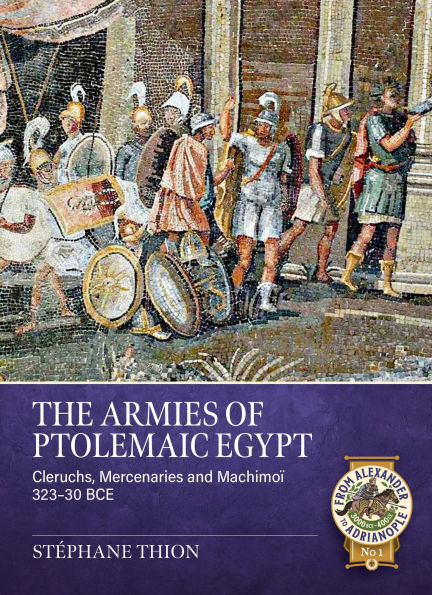The Armies of Ptolemaic Egypt: Cleruchs, Mercenaries and Machimoï 323-30 BCE
Egypt serves as the ideal starting point for anyone aiming to study the institutions of Alexander the Great’s successors. No other Hellenistic kingdom is as fortunate in possessing so many sources, particularly in the military field. The surviving documents provide profound insights into the army, extending even to the individual commanders and their soldiers. It is this army, heir to Macedonian traditions, that is described in detail in The Armies of Ptolemaic Egypt.
The organisation of the Ptolemaic army is described in detail over its centuries of existence, comparing theory with empirical data. The evolution of this organisation, reflecting the challenges of the time, becomes clear. One striking aspect of the Ptolemaic army is the modernity of its organisation. It was a far cry from the pyramidal structures described by contemporary tacticians, particularly Asclepiodotus in his ‘Tactica’. The situation is surprisingly reminiscent of seventeenth-century Europe.
The Armies of Ptolemaic Egypt is enriched by numerous illustrations, mainly based on statuettes, frescoes and painted stelae, revealing the Ptolemaic soldier as he appeared from the third to the first century BCE.
1147130411
The organisation of the Ptolemaic army is described in detail over its centuries of existence, comparing theory with empirical data. The evolution of this organisation, reflecting the challenges of the time, becomes clear. One striking aspect of the Ptolemaic army is the modernity of its organisation. It was a far cry from the pyramidal structures described by contemporary tacticians, particularly Asclepiodotus in his ‘Tactica’. The situation is surprisingly reminiscent of seventeenth-century Europe.
The Armies of Ptolemaic Egypt is enriched by numerous illustrations, mainly based on statuettes, frescoes and painted stelae, revealing the Ptolemaic soldier as he appeared from the third to the first century BCE.
The Armies of Ptolemaic Egypt: Cleruchs, Mercenaries and Machimoï 323-30 BCE
Egypt serves as the ideal starting point for anyone aiming to study the institutions of Alexander the Great’s successors. No other Hellenistic kingdom is as fortunate in possessing so many sources, particularly in the military field. The surviving documents provide profound insights into the army, extending even to the individual commanders and their soldiers. It is this army, heir to Macedonian traditions, that is described in detail in The Armies of Ptolemaic Egypt.
The organisation of the Ptolemaic army is described in detail over its centuries of existence, comparing theory with empirical data. The evolution of this organisation, reflecting the challenges of the time, becomes clear. One striking aspect of the Ptolemaic army is the modernity of its organisation. It was a far cry from the pyramidal structures described by contemporary tacticians, particularly Asclepiodotus in his ‘Tactica’. The situation is surprisingly reminiscent of seventeenth-century Europe.
The Armies of Ptolemaic Egypt is enriched by numerous illustrations, mainly based on statuettes, frescoes and painted stelae, revealing the Ptolemaic soldier as he appeared from the third to the first century BCE.
The organisation of the Ptolemaic army is described in detail over its centuries of existence, comparing theory with empirical data. The evolution of this organisation, reflecting the challenges of the time, becomes clear. One striking aspect of the Ptolemaic army is the modernity of its organisation. It was a far cry from the pyramidal structures described by contemporary tacticians, particularly Asclepiodotus in his ‘Tactica’. The situation is surprisingly reminiscent of seventeenth-century Europe.
The Armies of Ptolemaic Egypt is enriched by numerous illustrations, mainly based on statuettes, frescoes and painted stelae, revealing the Ptolemaic soldier as he appeared from the third to the first century BCE.
39.95
Pre Order
5
1

The Armies of Ptolemaic Egypt: Cleruchs, Mercenaries and Machimoï 323-30 BCE
136
The Armies of Ptolemaic Egypt: Cleruchs, Mercenaries and Machimoï 323-30 BCE
136Paperback
$39.95
39.95
Pre Order

Product Details
| ISBN-13: | 9781804518250 |
|---|---|
| Publisher: | Helion and Company |
| Publication date: | 10/30/2025 |
| Series: | From Alexander to Adrianople |
| Pages: | 136 |
| Product dimensions: | 7.10(w) x 9.80(h) x (d) |
About the Author
From the B&N Reads Blog
